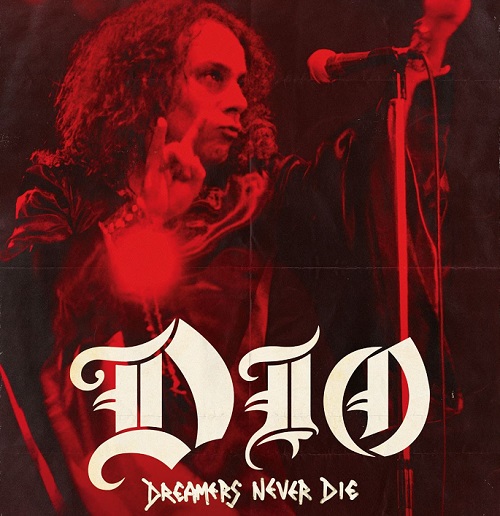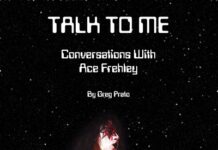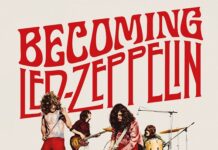If any rock and roll musician deserves a documentary, Ronnie James Dio has certainly earned his due. The singer, who died from gastric cancer in 2010, had his ups and downs over a career that began in the 1950s, and left an indelible mark on music and heavy metal, in particular. His story is one of can-do perseverance, unbridled talent, and immeasurable gratitude for his family, friends and fans. Dio: Dreamers Never Die, the documentary directed by filmmakers Don Argott and Demian Fenton, does an admirable job of covering the Dio’s entire life — from doo wop crooner to musician and songwriter to frontman for Rainbow, Black Sabbath and, Dio, his own band. And all the struggles and challenges that came with it.
Like most rock documentaries, the story is enhanced by any number of talking heads, including Dio’s cousin David “Rock” Feinstein, who played with him in the band Elf, radio personality and friend Eddie Trunk and Don Coscarelli, director of “The Last In Line” music video, plus band members like Vinnie Appice, Tony Iommi, Geezer Butler and Bill Ward from Black Sabbath and Heaven & Hell, Roger Glover from Deep Purple, Craig Goldy, who replaced guitarist Vivian Campbell in Dio, plus musicians like Rob Halford, Lita Ford, Glenn Hughes, Rudy Sarzo, Don Dokken, Sebastian Bach, rock journalist Mick Wall, actor Jack Black, and, of course, Dio’s wife and manager, Wendy Dio, whose own story gets worked into the narrative.
What DIO: Dreamers Never Die lacks in flash and quick-turn story-telling, it more than makes up in archive footage and a comprehensive study of its subject. Wendy Dio opened up the video vaults and her home (the bar was her husband’s favorite spot in the house) for this film. She even shows off the trumpet that Dio started his musical journey with. And the story picks up from there. We learn about the singer’s stern, conservative upbringing, his love of reading, his knack for mischief, and his musical beginnings.
We meet characters like Ron Wray, a former DJ, friend and Dio collector. He takes the viewer through Dio’s extensive history with any number of bands including Ronnie Dio and Redcaps, Ronnie Dio and the Prophets, and the Electric Elves, whose time came to a sudden end after a drunk-driving accident that killed guitarist Nick Pantas. Once Dio recovered from his wounds, he picked up and jumped back into the game with the band rebranded as Elf. And that’s when Dio attracted some major attention.
After recording their debut album with Deep Purple’s Roger Glover and Ian Paice, then going on the road with Deep Purple, Elf were on their way. This led to Dio’s association with Ritchie Blackmore, whose much-discussed mystic is maintained by his non-involvement with the documentary. Much is made of Dio’s time with Rainbow, but after finding his stride, Blackmore decided to change direction, with a desire for a wider audience. And that ended it for Dio. But not for long.
A chance meeting at the Rainbow Bar & Grill with Tony Iommi led to Dio joining Black Sabbath. Taking the place of Ozzy Osbourne, the singer was only a bong hit away from blowing everyone away, and keeping Sabbath among the A-levels. Along with making music with Sabbath, Dio came up with the devil-horns, by holding up his index finger and pinkie — something that would become associated with all of heavy metal. But internal issues, including drugs, alcohol, and ego, led Dio to parting ways with Sabbath.
In light of Dio’s career turning “sour” after experiencing worldwide success with two bands, the singer finally decided to create his own band, writing songs, recruiting Appice as his new drummer, and his wife as his manager. He headed to London where he brought in bassist Jimmy Bain, who told the singer about guitarist Vivian Campbell. The first incarnation of Dio was born. And judging by the tapes that Appice shares, the band’s potential was there from the beginning. The stories around “Rainbow In The Dark” are the stuff of legend. Even the cover of Holy Diver, Dio’s debut album, nets its own vivid account.
As Trunk accurately notes, Dio was a new beginning for Ronnie James Dio, who was in his early 40s when the band got together. In the 1980s, a new wave of heavy metal took over the music world, and Dio became one of the genre’s gurus, a “hero” of the scene. He even headed up Hear ‘n Aid, a heavy metal counterpart of “We Are The World.” But once grunge moved in, Dio’s style of music started to lose its luster. The singer carried on, recording new albums and touring smaller venues. Then he rejoined the guys in Sabbath, and his star rose once again.
With most everyone singing their praises of the singer’s soft-spoken disposition and personal kindness — while his image was more brooding, dark, and fantastical — it‘s an especially sad part of the film when his battle with cancer comes to light. As Wall describes, Dio had “hit the top of the mountain, slaying the dragon,” weathering the changes, maintaining that can-do work ethic, and reuniting with old friends and reclaiming the respect during what the singer called a “wonderful time in all of our lives.” And then, just as the ball got rolling, Dio’s received the diagnosis, and his life changed course once again, this time for good. Dio’s impact and tenacity is why DIO: Dreamers Never Die was even made. As the film reminds us, that attachment to fans — an attachment like no other — that drive to come back time after time, and that powerful voice are what made Ronnie James Dio and his story so special. Anyone with a passing fancy or a hardcore allegiance will take something away from watching DIO: Dreamers Never Die.
~ Shawn Perry




















